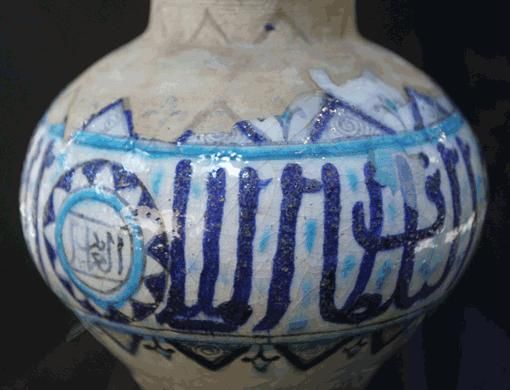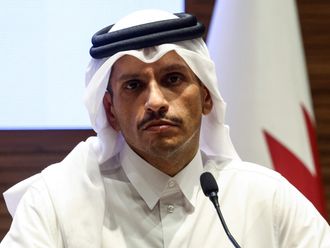Bahraini artist Dr Abdul Latif Jasem Kanoo is inviting everyone in the UAE to take a walk into Islamic history. And today is your last chance.
The 10-day exhibition - A Walk into Islamic History - has been on at the Abu Dhabi Cultural Foundation.
This is the first time the collection has been seen outside of Bahrain. And even that is not the whole collection of Islamic art that Kanoo owns, though it does give us an idea of the extent of Kanoo's fascination with history.
"I have been a private collector from both the Islamic and non-Islamic worlds for the past 50 years and constantly add new
things to them. I acquire and preserve Islamic art and heritage by covering a wide range of subjects and materials which illustrate the progress, dexterity and art of Muslim artisans throughout history," said Kanoo.
Kanoo has added to his collection through public sales and private purchases.
What you can see
Some of the works showcased in Abu Dhabi include artistic pottery and ceramics, glass, metals, arms and armour, rock crystal and jade, silver, ivory, wood, carved stonework, jewellery, books and manuscripts. There are also textiles, fabrics, rugs and carpets, cloths and fashion, coins, scientific instruments and manuscripts on Islamic science and medicine and a wide range of objets d'art.
Most of the Islamic pottery and ceramics span from the early unglazed ware of 9th and 10th century Syria, Iraq and Iran, to
later Iznik and Kutayah ware from Ottoman Turkey from the 17th to the 19th centuries.
Kanoo's collection also shows the development of glass-making in the Islamic world from the 9th to the late 18th century, illustrating methods like free and mould blowing, drawn and cut glass techniques, tinting, colouring and enamelling.
Metal art
The majority of Islamic metals are from Iran and the eastern side of the Islamic world and some go as far back as the 11th century. But they show various Islamic decorative techniques and design motifs through the ages - incisions, engravings and the use of calligraphy and silver inlay.
In addition to the works from Iran, there are also exhibits from Mamluk Syria, Ottoman Turkey, the Maghreb and Moghul India.
After Abu Dhabi, Kanoo plans to exhibit his collection in Bahrain before moving on to other countries in Europe.
Mustafa Al Mansouri, an Iraqi doctor who was visiting the exhibition, was impressed with the amount of artwork collected. "I was delighted to see some artwork from my country. It's impressive. I will definitely encourage my family and friends to come and visit since after the war, there are few works of art left in Iraq. Many were stolen."
Why Abu Dhabi
Dr Abdul Latif Jasem Kanoo told tabloid! that he chose Abu Dhabi to exhibit his precious collection for three reasons. He
appreciates the capital's cultural development witnessed throughout the years. The exhibition also reveals how Muslims used to live in their houses. It's real and this is important to expose.
The timing is also important. Ramadan is a time when people would like to see works of art which relate to their history and culture. Families and particularly children can come and witness what Muslims have contributed to human civilisation.
Students' visit
Over 250 students visited the Walk into Islamic History exhibition on Tuesday. The visit, by students from Abdul Jalil Al Fahim public school and Al Ahnaf Bin Qais public school, marks a leap in the capital's initiative to get national students
actively involved in its growing cultural movement.
In a meeting with Hoda Kanoo, founder of ADMAF (Abu Dhabi Music and Arts Foundation), Dr Hanif Hassan, Minister of Education, said that the ministry would endeavour to engage public school students in all cultural events in the capital, in a bid to encourage creative thinking and to capitalise on the country's budding talents.
A few of his favourite things
Dr Abdul Latif Jasem Kanoo has his favourites, one of them being the multicoloured glass that should make people appreciate their heritage, especially since it is no longer produced.
Rare
He also talked about a small jar with an inscription of "Allah" in the centre. "That is a rare piece," he said. Others
include a coloured candle stand from the Mamluk period, made of clay and an Iznik plate from 14th century Turkey that stands out due to its colour. The original colour of the plate and decoration is black and red.
In addition, he mentioned a number of rare materials from the early Fatimid period of Egypt, books such as Dalal Al Qhairat (or Guidance of believing in God and praising of the Prophets). In the centre, there are two drawings of Makkah and Madina with 16 different impressions which he said are rare to find.
"One piece of art where everyone should stop is a carpet from Mughal India - from the Shahnameh period. It has beautiful
colours and part of it is in perfect condition, though there are parts that are ragged due to its old age. It's an example of
weaving in India during that period," he said.
Necklace
He also praised the 15th century Bahraini pearl necklace, which is rare because of its large size and the fact that it is
still in perfect condition.
"People should appreciate how Muslims and Prophets developed art to make it a reality so that it remains precious for centuries," says Kanoo.












